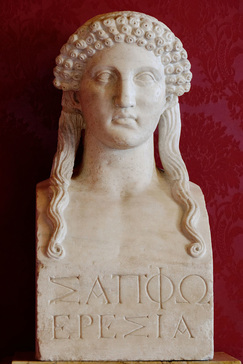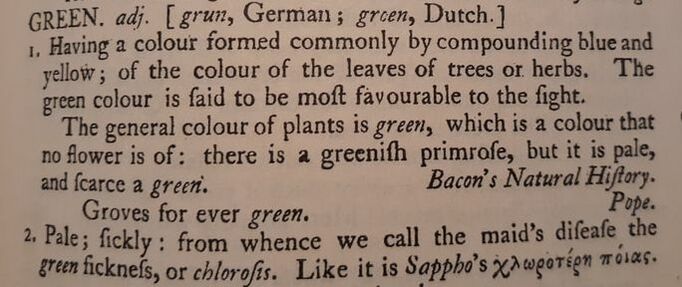
Authority Cited: Sappho
Author name and dates: Sappho (c.630-c.570 BCE)
BKG Bio-tweet: Greek lyric poet; born on Lesbos; highly regarded in antiquity; poetry fragments survive: SJ cites in related sense of green
Categories (list of works cited – preliminary) BKG Note: one Sappho cite in 1755 Dict. vol. 1. No Sappho cites were identified as added in the 1773 Dict.]
Author name and dates: Sappho (c.630-c.570 BCE)
BKG Bio-tweet: Greek lyric poet; born on Lesbos; highly regarded in antiquity; poetry fragments survive: SJ cites in related sense of green
Categories (list of works cited – preliminary) BKG Note: one Sappho cite in 1755 Dict. vol. 1. No Sappho cites were identified as added in the 1773 Dict.]
- Sappho: Sappho fragment 31 in ‘Longinus’ On the Sublime 10.1-3; green [BKG Note: See image below for the Dict. quote. Sappho is also referred to in other quotations, for example of Addison, Pope, and Prior. Next to Homer, Sappho is the oldest authority cited in the Dict. The edition of 'Longinus' used or recalled by SJ is unknown. SJ's Greek phrase may be from memory, as the phrase in 'Longinus' as given in Loeb is slightly different. The text was first published (in Greek) in Basel in the 16th century. The complete Greek and English text of the fragment, with the 'Longinus' discussion, can be found in Greek Lyric, Volume I: Sappho and Alcaeus, edited and translated by David A. Campbell. pp. 79-80, Loeb Classical Library, 1982 (reprinted with corrections, 1990), Harvard University Press, Cambridge, Massachusetts and London, England.]
Prof. Stephen E. Hinds of the University of Washington, Seattle, Classics Department has kindly provided the following:
The Johnson Sappho quotation is from the famous Sappho fragment 31, as quoted and discussed by ‘Longinus’ in On the Sublime. The author's name is conventionally cited in quote marks because the traditional attribution to Longinus is believed to be false; but it’s a work of the first century AD; ‘greener than grass’ = ‘chlorotera de poias’ (transliteration of the Loeb phrase) is in line 14 of the fragment.]
